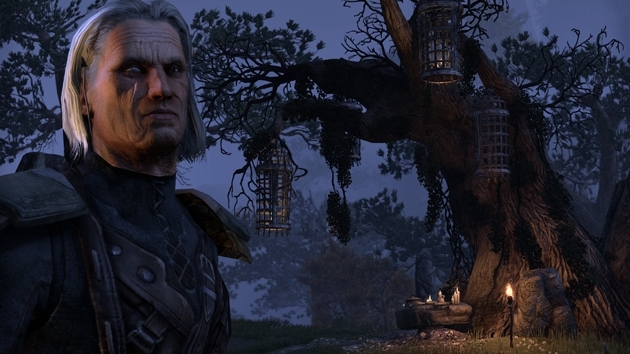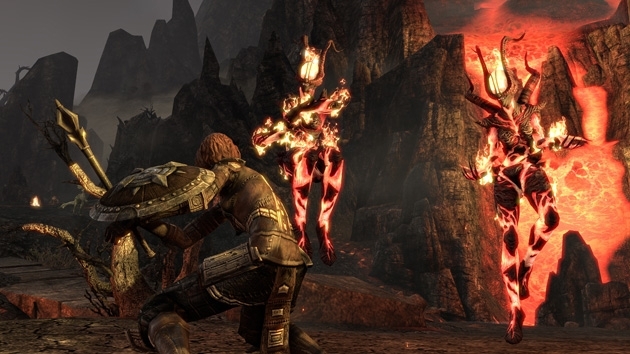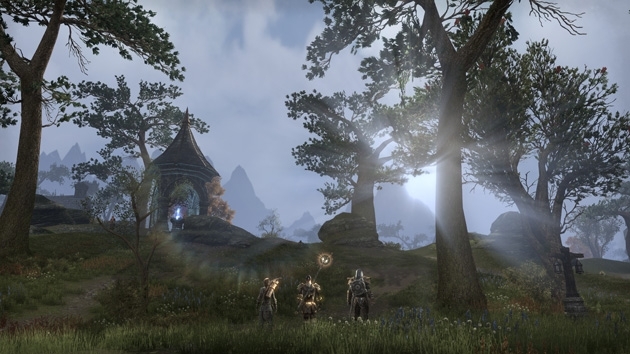The Elder Scrolls Online: Making a Promise
ZeniMax General Manager Matt Firor talks about entertaining us from month to month.

While the world of Tamriel needed to be updated, both for next-gen hardware and a different point in time, I was curious to know what else the team had borrowed from other games in the series. But, as Firor explained to me, it’s not all about copy-paste.
“The last three Elder Scrolls were, obviously, vastly more popular than the first two, mostly because the market was bigger and they were available on multiple platforms. But really, you can see a clear evolution from Morrowind to Oblivion to Skyrim. Things like ease-of-use, refined combat systems and so on.
“We looked at all of that. But we don’t copy those. We try to take what’s best about those systems and try to make them work in this online world. The skill system – you can always reload a save game if you mess up a skill choice in Oblivion, for example. You can’t do that in our game, so we need to make it a little more flexible and interesting, but keep the idea of skill points, skills that level when you’re using them. That’s why you’ll see things that are similar, but they’re not always exactly the same, because we have to make sure it works with other people in the picture.”
Surprisingly though, that choice to launch on next-generation consoles doesn’t seem to have hampered development much. Although the subscription might be a tough sell for gamers already paying for Xbox Live Services (Firor added that “We are working with our partners right now on that”), the team doesn’t seem limited by that shiny new hardware.
“We could never have done this on the previous generation console. There would have been too many compromises, and it never would have worked. But the next-gen consoles are actually pretty powerful PCs at their heart – as powerful as our recommended spec.
“So the problems we’re trying to solve with that really fall into two categories. One, playing with a controller in your hand, which isn’t rocket science. It’s mostly making sure everything maps well – we have Skyrim and Oblivion that we can look at for their mapping schemes.
“The other is voice chat versus text chat on a keyboard. Obviously nobody has a keyboard on console, so the design for how voice chat works is very important. But graphics? Exactly the same. UI? Exactly the same. Gameplay? Exactly the same. Because it’s a PC.”

Beta Build-up
With over three million players already signed up for beta, there’s definitely a huge amount of anticipation for the game. But while Firor tells me that eager gamers are still clamouring for invites, they already have thousands of testers checking out the game and stressing systems, ramping things up over the previous 9 months.
“We have two basic types of beta test. One is a long play, where you get in for a couple of days, go through a zone, and the servers are up for a longer time. And then we have a stress test, and that’s what you’re seeing [in August] with the two waves of invites. And that’s to invite a whole bunch of players, and try to make things break. Because you want to make them break early in beta so that a lot of players aren’t exposed to it, because it’s not fantastically fun for them when the servers die.
“The stress tests for us are to get a whole lot of players on, just hit a button, and take the servers down, bring them back up, and see what happens when everyone gets back in. We’ve learned a ton from that. We’re up in the tens of thousands of beta testers now, and it’s just going to keep going from there.”
Although the mini-map to compass change was one example, I asked Firor if there were any other interesting areas of feedback that he’d had from beta. He replied with a game developer’s adage about beta testers: “no matter how good you think your game is, when players hit it they definitely have their own opinions.”
“The game’s been in development for a while, and we have parts of the game that are older than other parts. The players have actually figured that out already. ‘That zone doesn’t feel like this zone,’ and that’s actually true, because you learn a lot while you’re doing this. The polish that I’m talking about, and teams going back in, where players are talking about zones. We look at the differences, go in and polish it.
“And that’s just one thing. There’s combat polish, which goes on forever. Player skills that need tweaking and balancing, animations that players think look a little off, because there’s some problem with it – all of that falls under beta feedback.”

Moving on from beta, I asked Firor how endgame was shaping up. I was particularly eager to hear if there’d been any update to Adventure Zones, a concept Firor last mentioned to Scott Hawkes back in March.
“We have a couple of endgames. One is the PvP system, the other is this Adventure Zone concept. We’re still working on it, because we’ve got to get it right. It’s one of the last things that we’re doing.
“We have high end PvE already. We have dungeons scattered around the world, they have heroic lairs which are pretty cool because you go into a dungeon when you’re levelling, and there’s a story. You can go back to it at level 50 and it’s the same dungeon, but the story continues from where you ended. You’re going through it and it looks familiar, but then you get to a point and there’s this whole new area that you go into.
“That is one part of it, but we also have this Adventure Zone concept, where you can do large group PvE as well as more dungeon runs. We’re working on how that fits into the world right now.”
I followed up by asking Firor if those were our only choices at endgame. “It all depends on what you mean by endgame. The short answer is yes – you play through your alliance and that gets you to level 50. But our skill system is usage based, so even at level 50 you could drop your sword and pick up a bow – it doesn’t cap you at learning things.”
That said, there will still be the ongoing story delivered every four to six weeks, as Firor mentioned earlier. He also explained how we’ll be able to experience all of The Elder Scrolls Online’s three alliances, with the game increasing in difficulty as we progress.
“When you get to the end of your main story – the Alliance story – you can then go play the other two alliances, and it’s three times the content. The way we set it up is that your Alliance is 1 to 50, the next Alliance is 50+, so you get better loot drops and a little more difficult, but soloable. The third Alliance is 50++, you’re getting much better drops as you go through it. Some of that you might not be able to solo at the upper reaches, as you get to the ‘150th’ level. When you go to those areas, it’s actually a special version of the world where all the AI and monsters are levelled to 50, so you’re actually playing it on your difficulty level. That is really solo endgame stuff – think of your favourite MMO daily quests and, instead of doing that, you’re doing quest content as part of a story for an alliance.”
The Elder Scrolls Online is due to hit PC, Mac and next-generation consoles in spring 2014. If you’re eager to jump into Tamriel before then, you can join 3 million other players and sign up for beta on the official site.
Gareth “Gazimoff” Harmer, Senior Contributing Editor
Follow me on Twitter @Gazimoff



